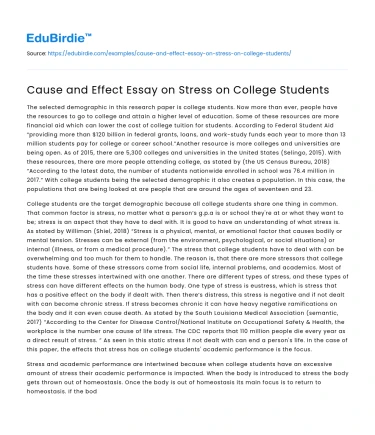The selected demographic in this research paper is college students. Now more than ever, people have the resources to go to college and attain a higher level of education. Some of these resources are more financial aid which can lower the cost of college tuition for students. According to Federal Student Aid “providing more than $120 billion in federal grants, loans, and work-study funds each year to more than 13 million students pay for college or career school.”Another resource is more colleges and universities are being open. As of 2015, there are 5,300 colleges and universities in the United States (Selingo, 2015). With these resources, there are more people attending college, as stated by (the US Census Bureau, 2018) “According to the latest data, the number of students nationwide enrolled in school was 76.4 million in 2017.” With college students being the selected demographic it also creates a population. In this case, the populations that are being looked at are people that are around the ages of seventeen and 23.
College students are the target demographic because all college students share one thing in common. That common factor is stress, no matter what a person’s g.p.a is or school they're at or what they want to be; stress is an aspect that they have to deal with. It is good to have an understanding of what stress is. As stated by Williman (Shiel, 2018) “Stress is a physical, mental, or emotional factor that causes bodily or mental tension. Stresses can be external (from the environment, psychological, or social situations) or internal (illness, or from a medical procedure).” The stress that college students have to deal with can be overwhelming and too much for them to handle. The reason is, that there are more stressors that college students have. Some of these stressors come from social life, internal problems, and academics. Most of the time these stresses intertwined with one another. There are different types of stress, and these types of stress can have different effects on the human body. One type of stress is eustress, which is stress that has a positive effect on the body if dealt with. Then there’s distress, this stress is negative and if not dealt with can become chronic stress. If stress becomes chronic it can have heavy negative ramifications on the body and it can even cause death. As stated by the South Louisiana Medical Association (semantic, 2017) “According to the Center for Disease Control/National Institute on Occupational Safety & Health, the workplace is the number one cause of life stress. The CDC reports that 110 million people die every year as a direct result of stress. ” As seen in this static stress if not dealt with can end a person's life. In the case of this paper, the effects that stress has on college students' academic performance is the focus.
Save your time!
We can take care of your essay
- Proper editing and formatting
- Free revision, title page, and bibliography
- Flexible prices and money-back guarantee
Stress and academic performance are intertwined because when college students have an excessive amount of stress their academic performance is impacted. When the body is introduced to stress the body gets thrown out of homeostasis. Once the body is out of homeostasis its main focus is to return to homeostasis. If the body is unable to return to homeostasis then it starts to affect the body. A person's ability to return to homeostasis is in part due to their ability to deal (cope) with the perceived stress. The problem is that most college students either don't have the resources or the personal tools to deal with stress. They never deal with their stress and the body is unable to return the homeostasis. This is where stress starts to affect academic performance. According to a study conducted by Aafrreen (2018), “ Excessive stress among students was found to reduce the effectiveness of their study which contributes to bad habits and results in negative long-term consequences, including absenteeism, poor academic performance, and school dropout.” In order to stop stress from affecting college students' academic performance they must be given the proper tools to cope, with and perceive different types of stress and stressors. There are different theories in health promotion that can provide these tools to college students.
The social cognitive theory also known as SCT is the theory being used. The social cognitive theory was developed by Alber Banaranike in 1986 (introduction to health promotion). This theory is intertwined with physiologics in the aspect that the concept of reciprocal determinism. What this concept is according to Anastasia (Snelling, 2014) “. SCT embraces the idea that humans do not live in isolation and learn and behave not only according to their own thought processes but also in response to the environments that surround them in terms of the environment of a group (workplace, for example) or the larger society as a whole” (p. 27). In this concept, a person's actions and thoughts are not only their own but are a product of their environment. In other words, a person is affected but also affects their environment. Another aspect of this theory is that the person knows the health risks of their behavior. This theory also uses the concept of internal locus of control. Internal locus of control is when the person has a strong belief that their health and health choices are in their control. The social cognitive theory in order to give a person a strong internal locus of control and an understanding of the risk factors and consequences that a certain behavior has. What is good about the internal locus of control is that it allows a person to make great changes and overcome damaging health behaviors.






 Stuck on your essay?
Stuck on your essay?

